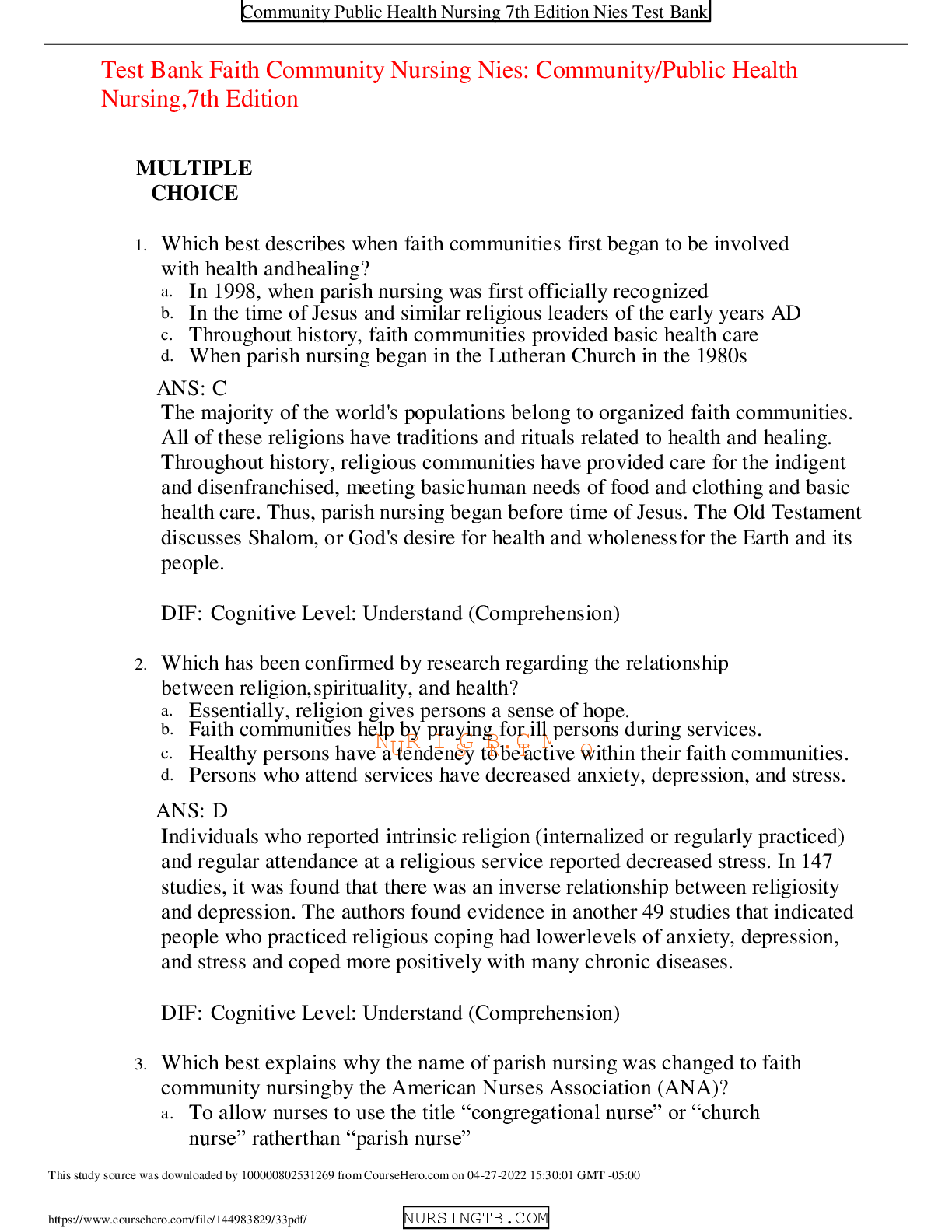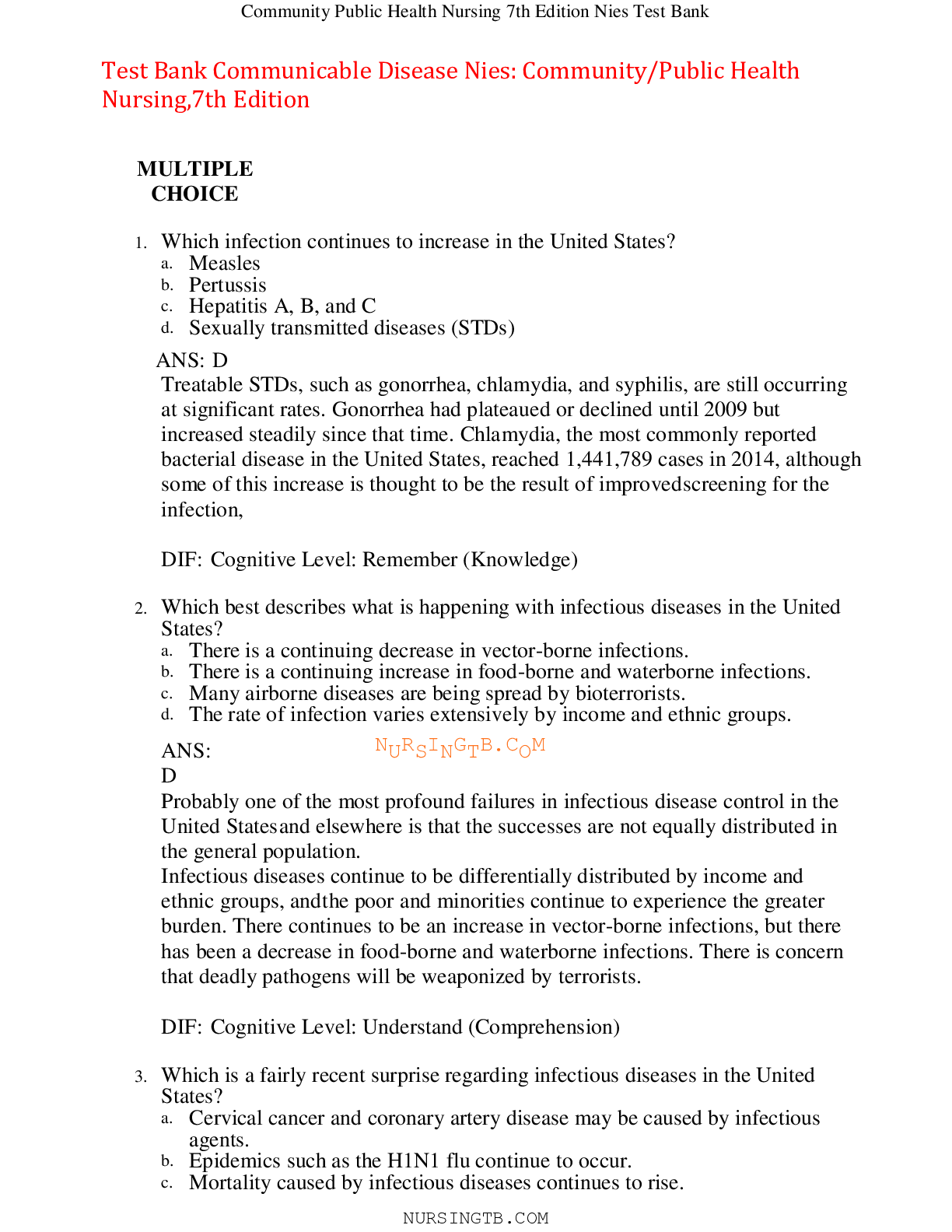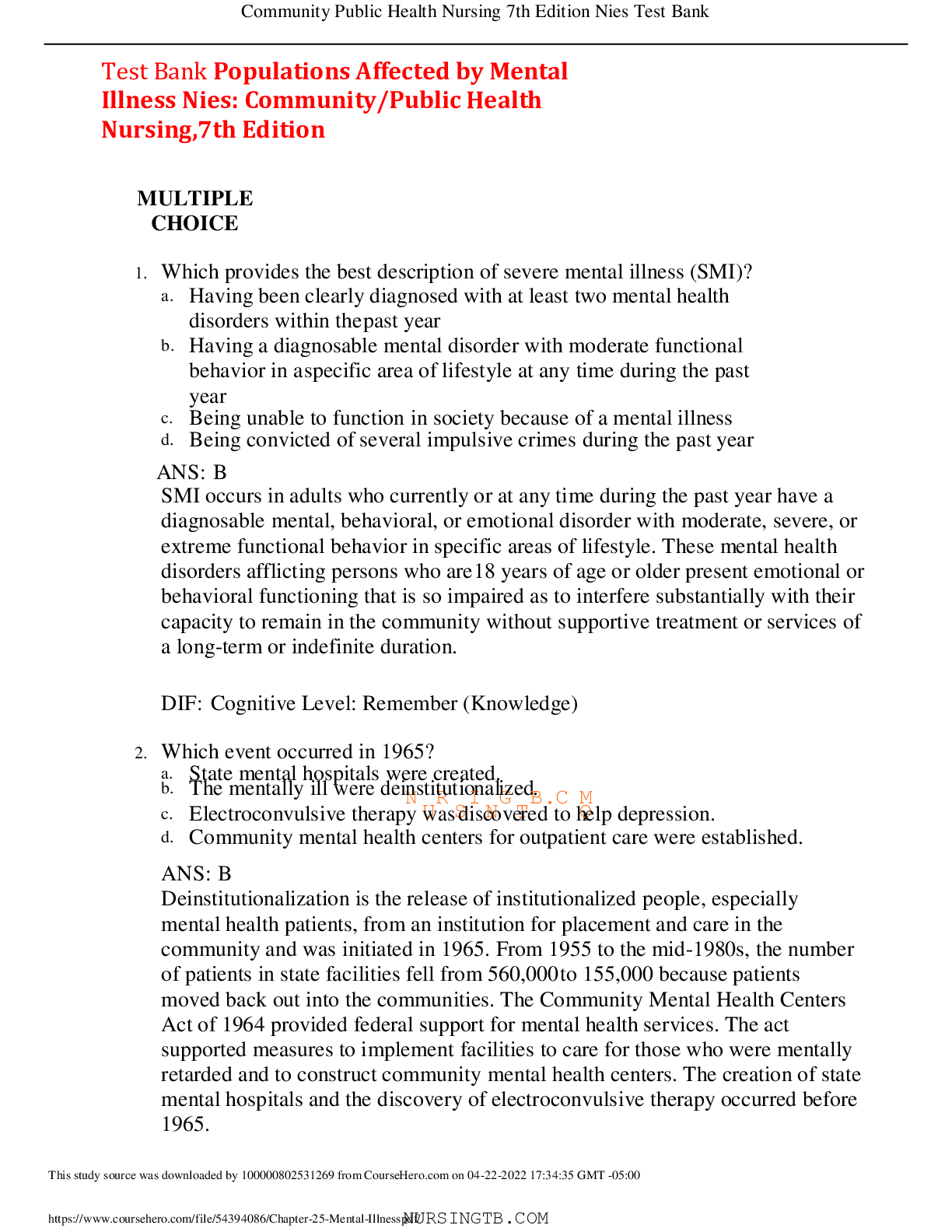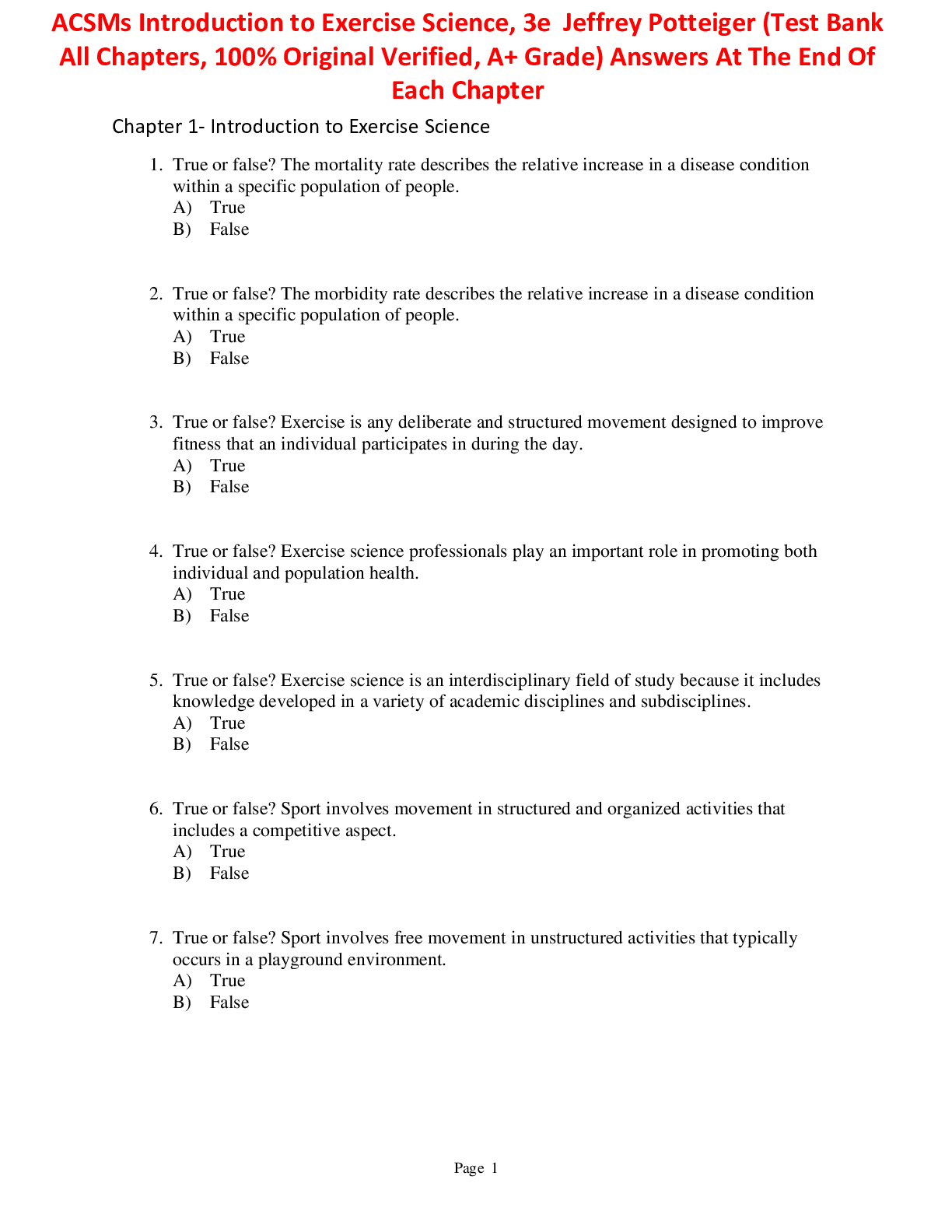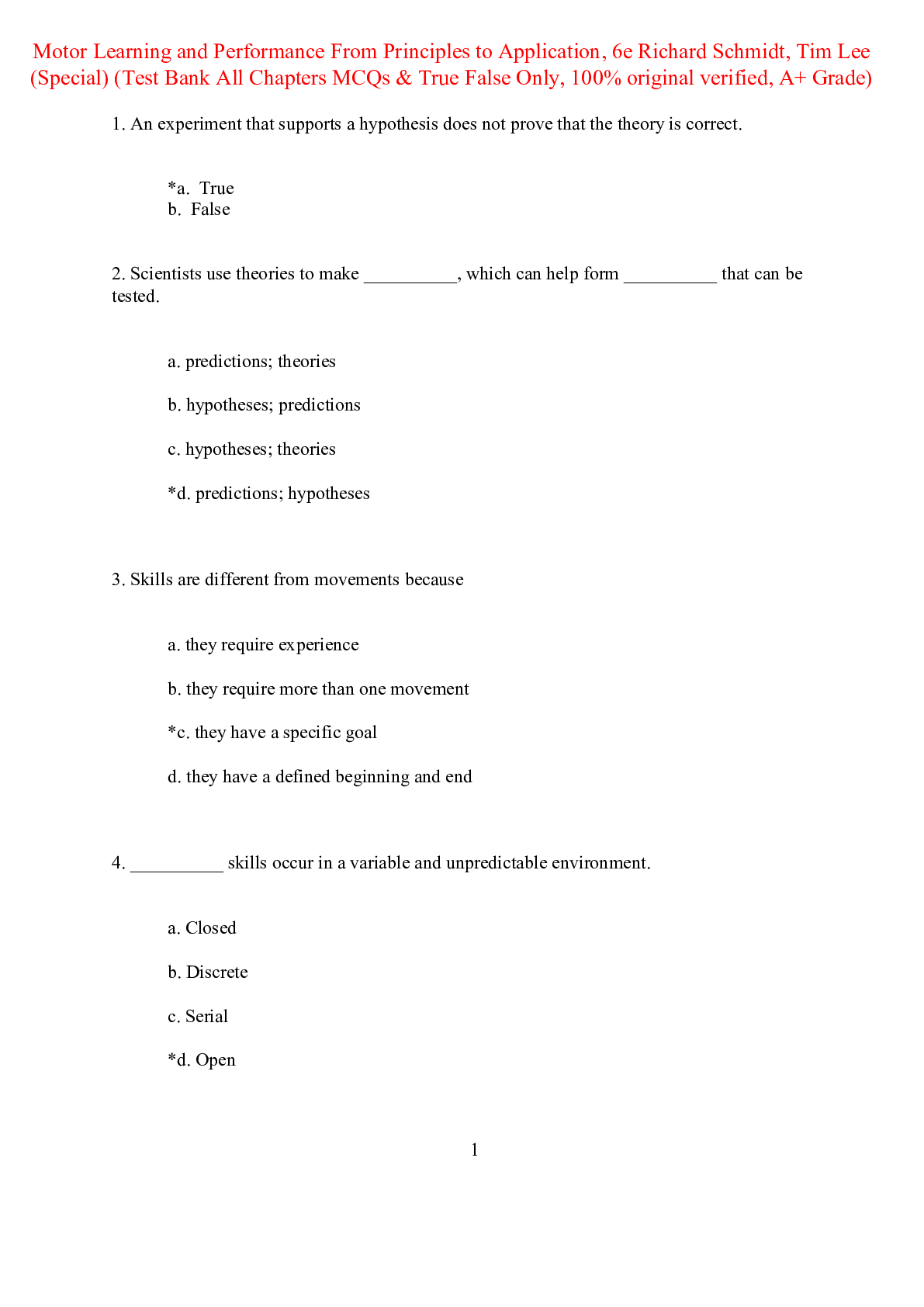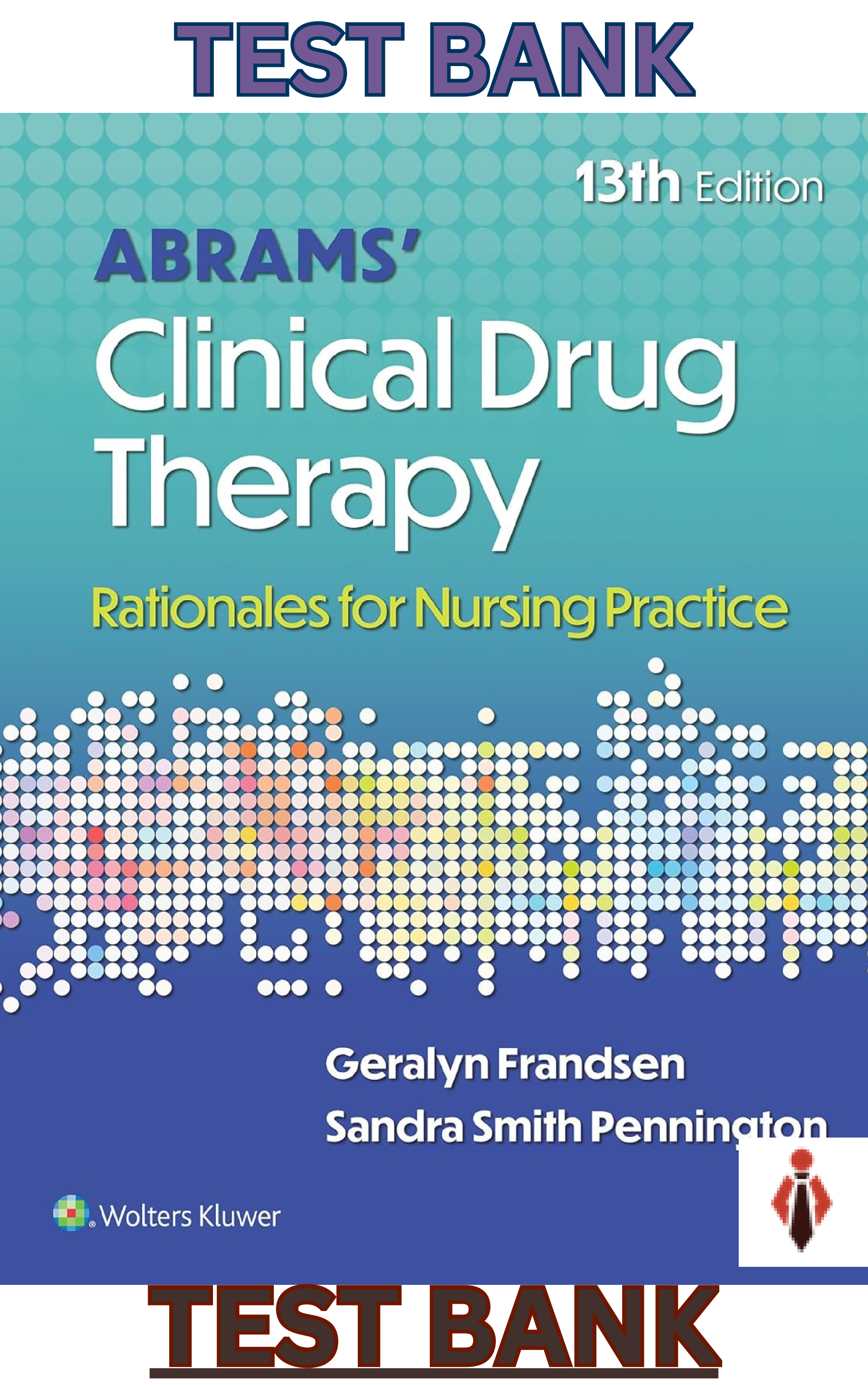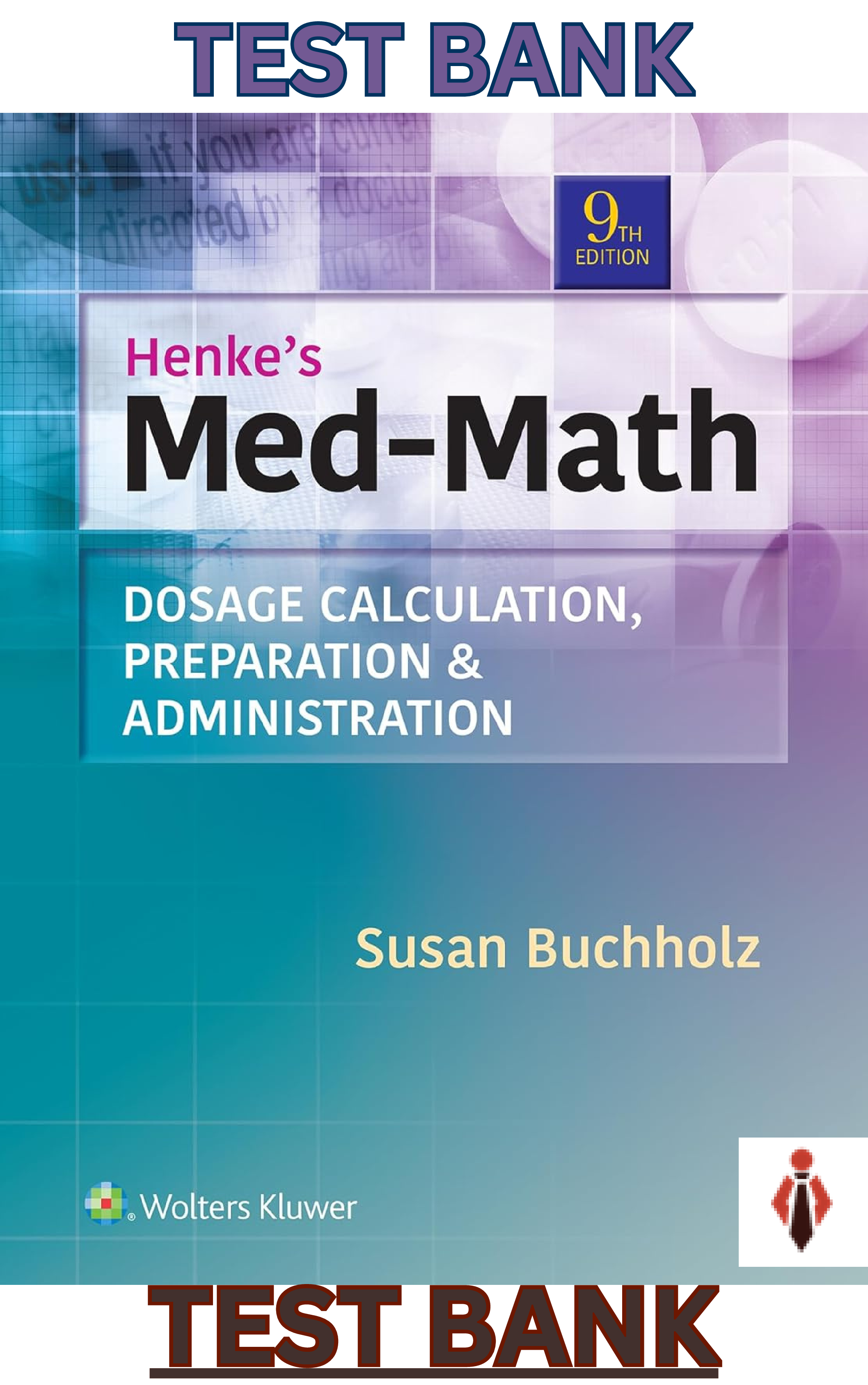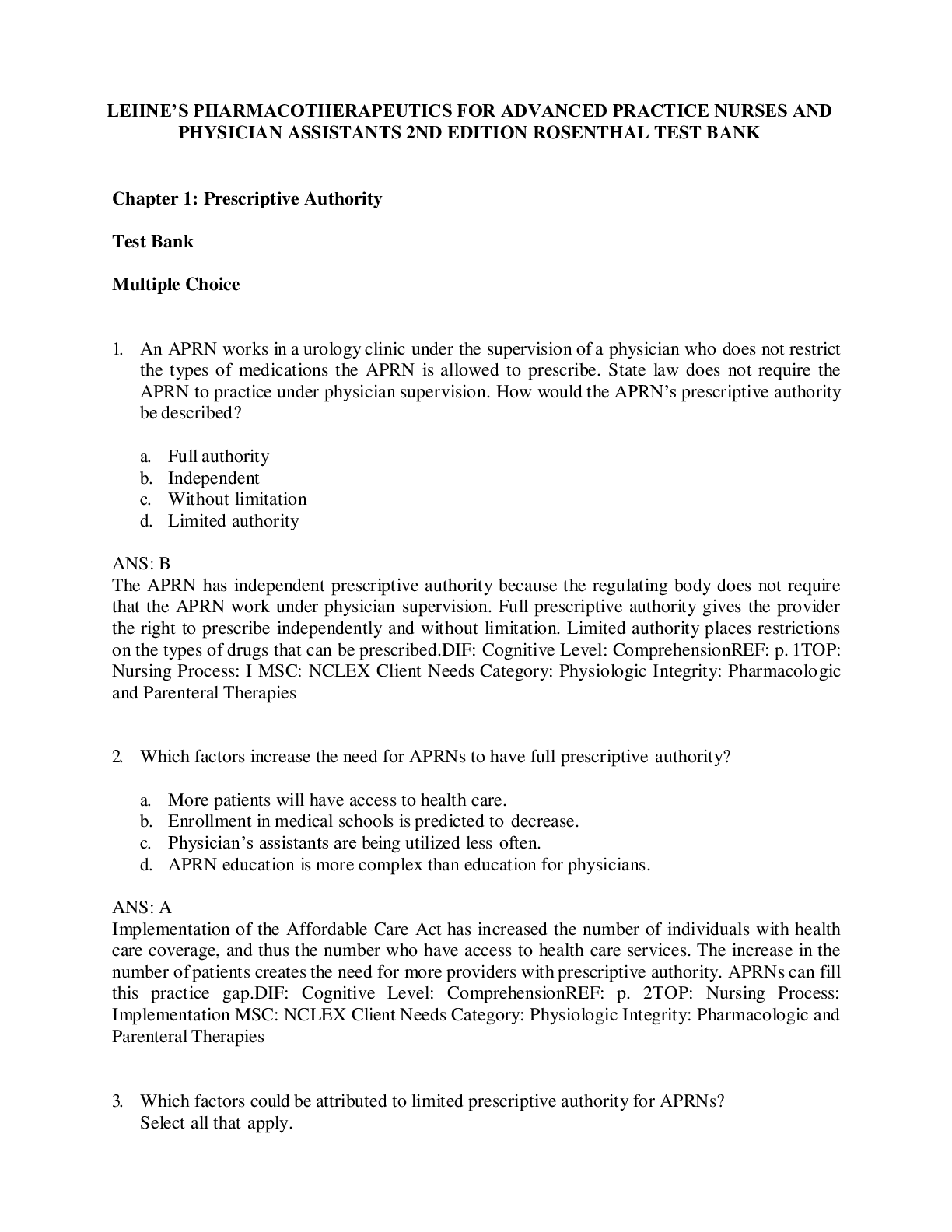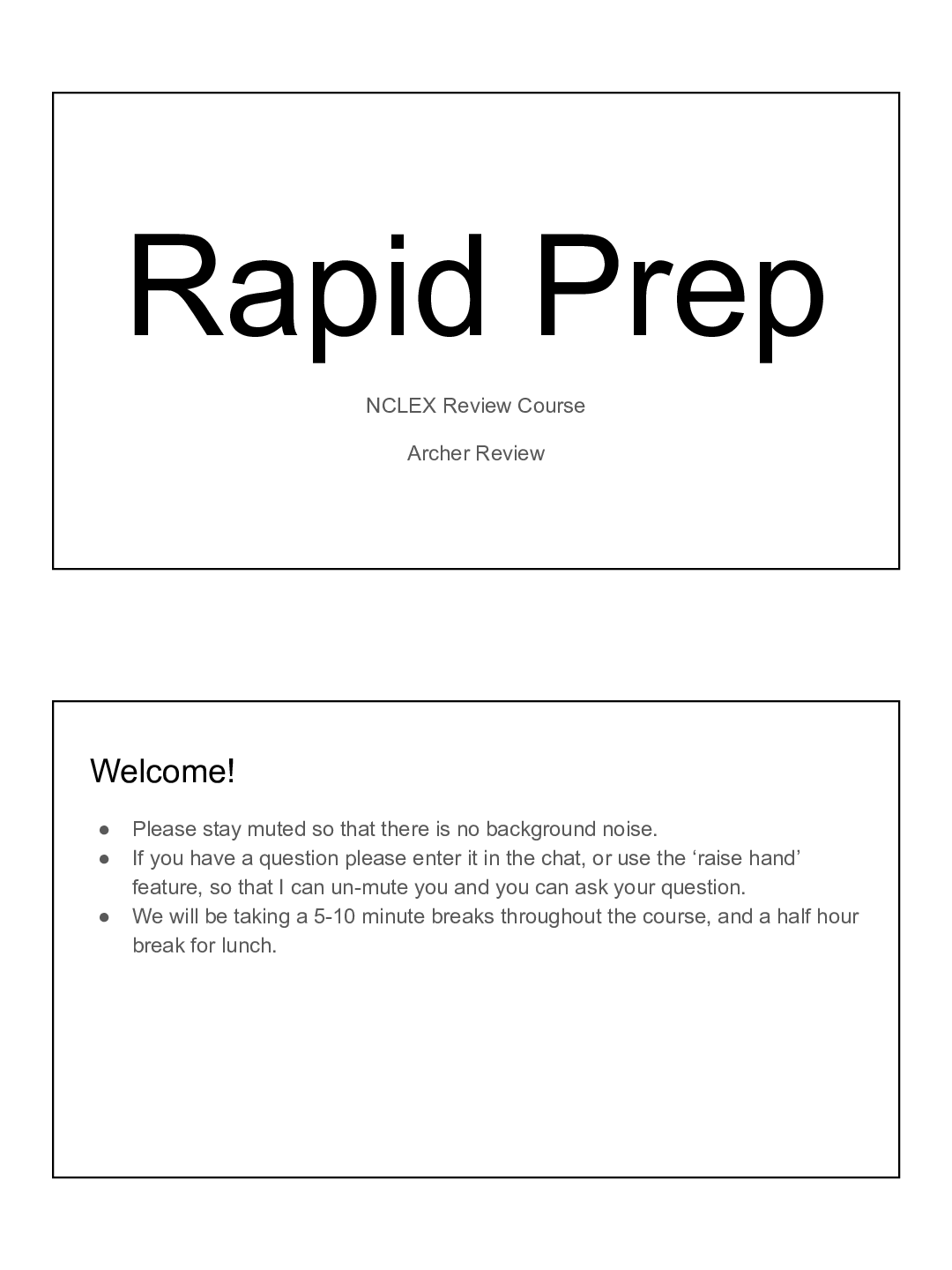*NURSING > TEST BANK > Test Bank Veterans Health Nies: Community/Public Health Nursing,7th Edition,100% CORRECT (All)
Test Bank Veterans Health Nies: Community/Public Health Nursing,7th Edition,100% CORRECT
Document Content and Description Below
Test Bank Veterans Health Nies: Community/Public Health Nursing,7th Edition MULTIPLE CHOICE 1. Which person meets the legal definition of a veteran? a. A 32-year-old male who has been dishono... rably discharged from the Army b. A 50-year-old female who retired from the Navy c. A 65-year-old male who served in the National Guard d. A 22-year-old female who is currently serving in the Air Force ANS: B Legally, a veteran is an individual who has served in the active military, naval, or air service and who was discharged or released under conditions other than dishonorable. Any individual who completed service for any branch of armed forces is a veteran as long as they were not dishonorably discharged. Personnel serving in the National Guard are considered to be part-time employees and not active duty, full-time personnel. DIF: Cognitive Level: Understand (Comprehension) 2. Which is the largest branch of the U.S. military? a. Navy b. Marine Corps c. Coast Guard d. Army ANS: D NURSINGTB.COM The U.S. Army is the largest branch of the military, making up 39% of all military personnel. Other branches of the service include the Air Force, the Navy, the Marine Corps, and the Coast Guard. DIF: Cognitive Level: Remember (Knowledge) 3. A client is describing the time period that he served in the National Guard. Which statement would he be most likely to make? a. “I completed monthly drills and 2-week annual trainings.” b. “I achieved the rank of officer and was promoted to the U.S. Army.” c. “I served overseas based on decisions made by the federal government.” d. “I selected Japan as my destination for my overseas tour of duty.” ANS: A Personnel serving in the National Guard or Reserves are considered part-time employees. The key difference among them is that the Reserves report to the federal government, whereas the National Guard is administered by each state (e.g., the Pennsylvania National Guard is called into action by the governor of Pennsylvania). These individuals serve no more than 39 days a year, unless called into action. Usually, their service consists of monthly drills and 2-week annual trainings. Reservists may be called very suddenly to active duty (full-time) for deployments, requiring that they leave their family, regular job, and community for a time. The National Guard and Army are two separate entities—promotion does not change the military that is being served. DIF: Cognitive Level: Apply (Application) 4. A veteran is receiving veteran’s health care benefits. Which department directly coordinates these benefits? a. Veterans Benefits Administration (VBA) b. Veterans Health Administration (VHA) c. U.S. Department of Veterans Affairs (VA) d. Civilian Health and Medical Program of the Department of Veteran’s Affairs (CHAMPVA) ANS: B The Department of Veterans Affairs has three subdivisions: the VHA, the Veterans Benefits Administration (VBA), and the National Cemetery Administration. The VHA provides all types of health care in every setting, including inpatient, outpatient, and long-term care. The VBA is an administrative arm responsible for unemployment and pension payments, home loans, vocational training, and educational benefits. The Civilian Health and Medical Program of the Department of Veterans Affairs (CHAMPVA) is a program in which the costs of some health care services for eligible civilian beneficiaries are covered by the VA. DIF: Cognitive Level: Apply (Application) 5. A nurse is interviewing a client to determine if she is eligible for VA benefits. Which question would assist the nurse in determining the requirement of service? a. “Did you serve active duty for 24 consecutive months?” b. “Which branch of the military service did you serve?” c. “Were you dishonorably NdiscRharIged?G” B.C M d. “How long has it been sincUe yoSu leNft thTe militaOry?” ANS: A Veterans—and sometimes their survivors and dependents—are eligible for VA benefits when they fulfill two requirements related to service and separation. (1) Service: they must have served in active duty for 24 consecutive months or for a full period of call (Reserves and Guard). There are some exceptions to the length of service minimum, the most important being when a person is discharged for disability incurred or aggravated in the line of duty. (2) Separation: they must have been separated under any condition other than dishonorable. DIF: Cognitive Level: Apply (Application) 6. A client reports hearing loss and tinnitus following military duty in the Gulf War. Which term would best describe this client’s injury? a. Posttraumatic stress disorder b. Polytrauma c. Traumatic brain injury d. Service-connected disability ANS: D A service-connected disability is a disease or injury that was incurred as a result of or during the veteran’s active duty, or one that was aggravated by military service. Posttraumatic stress disorder is a mental illness that develops in some individuals who have experienced a shocking, frightening, or dangerous event. A traumatic brain injury is a disruption of brain function caused by an external mechanical force, including blunt force trauma, penetration by a foreign object, acceleration or deceleration movements, and pressure waves from explosive blasts. The term polytrauma refers to two or more injuries sustained in the same incident, affecting multiple body parts or organ systems, and resulting in various kinds of impairments and functional disabilities. Polytrauma is often the result of a blast-related event and frequently includes TBI. DIF: Cognitive Level: Apply (Application) 7. A veteran tells the nurse that he hates the VA health insurance program and wishes that he would be allowed to see the local doctor instead of traveling to the VA clinic. Which statement would be most appropriate to be made by the nurse? a. “I will check to see if your local doctor can be added to the list of approved providers.” b. “Yes, you pay premiums for this health insurance and should be able to have a choose what providers you see.” c. “The VA does not provide health insurance, rather this is a benefit that you receive for compensation for your service to our country.” d. “The VA provides different benefit plans. Let me see if the local doctor is a provider on a different benefit plan.” ANS: C Many veterans do not realize that their care at their VA hospitals and clinics is not a type of health insurance. Instead, it is aUbeSnefiNt thaTt they rOeceive in compensation for their duty and service to the country. The difference between health insurance and VA health benefits is twofold. First, veterans do not have to “pay into” their VA benefits the way one would pay premiums for a health insurance plan. Second, the “coverage” received in the form of VA benefits is not transferable to other non-VA providers, except through formal contracts deemed appropriate by the VA and its providers. DIF: Cognitive Level: Apply (Application) 8. A veteran has been diagnosed with an immersion foot injury. Which finding should the nurse anticipate when completing an assessment on the client? a. A foot that is deformed b. A foot that is unable to tolerate immersion in water c. A foot that the client is unable to bear weight on d. A foot that has occasional numbness ANS: D The major cold injuries veterans suffer include frostbite, nonfreezing cold tissue damage, immersion foot (formerly called trench foot), and hypothermia. Cold injuries may result in long-term health problems, including the following signs and symptoms (at the site of exposure): changes in muscle, skin, nails, ligaments, and bones; skin cancer in frostbite scars; neurological injury with symptoms such as bouts of pain in the extremities, hot or cold tingling sensations, and numbness; vascular injury with Raynaud phenomenon with symptoms such as extremities becoming painful and white or discolored when cold. DIF: Cognitive Level: Apply (Application) 9. A veteran has recently been diagnosed with posttraumatic stress disorder (PTSD). Which information obtained from the client during a health history would align with this diagnosis? a. The client reports that he has a history of hypertension and hyperlipidemia. b. The client states that he served as a sniper during the Gulf War. c. The client states that he was stationed in Japan. d. The client reports that his wife has a substance abuse problem. ANS: B PTSD is a mental illness that develops in some individuals who have experienced a shocking, frightening, or dangerous event. Factors that contribute to an individual developing PTSD include getting injured or seeing another person injured, viewing a dead body, feeling helpless, having little or no social support after a traumatic event, dealing with extra stress after the event (e.g., loss of a loved one, pain and injury), or having a history of mental illness or substance abuse. DIF: Cognitive Level: Apply (Application) 10. Which statement about military sexual trauma (MST) is accurate? a. MST is more common among male veterans. b. The majority of women who report MST state the perpetrator was an intimate partner. c. An Army veteran is at greatest risk to report MST. d. Insomnia is more severe among veterans who report a history of MST. ANS: D NURSINGTB.COM MST is more common among women veterans, with 32.4% reporting MST compared with 4.6% of their male counterparts (Klingensmith et al, 2014). It is estimated that in one of seven women who report MST, the trauma was perpetrated by an intimate partner (Mercado et al, 2015). Insomnia is more common and more severe among veterans who report a history of MST (Jenkins et al, 2015). One of the risk factors/characteristics of veterans experiencing MST is being a Navy veteran, not Army. DIF: Cognitive Level: Understand (Comprehension) 11. A nurse is caring for a veteran who has suffered a polytraumatic injury. Which would be the primary consideration for the nurse when working with this client? a. Use of an assistive device for ambulation may be necessary. b. Diagnosis of posttraumatic stress disorder will be likely. c. Physical and cognitive abilities to complete ADLs independently may be lacking. d. A psychiatric referral will be needed. ANS: C The term polytrauma refers to two or more injuries sustained in the same incident, affecting multiple body parts or organ systems, and resulting in various kinds of impairments and functional disabilities. Polytrauma is often the result of a blast-related event, and frequently includes TBI. For example, a soldier who has lost a limb, suffered a TBI, and lost his eyesight from a rocket-propelled grenade attack is said to have a polytraumatic injury. Care for veterans with these injuries is especially complicated because of the presence of several overlapping physical and cognitive impairments affecting their ability to perform ADLs. The primary consideration would relate to the client’s impairments in completing ADLs. DIF: Cognitive Level: Analyze (Analysis) 12. Which is the most prevalent type of substance use problem among male and female veterans? a. Binge drinking b. Overuse of prescription drugs c. Marijuana use d. Use of smokeless tobacco ANS: A Binge drinking and cigarette smoking are the most prevalent types of substance use problems among male and female veterans, affecting about 11% of the veteran population, with disorders more common among males younger than 25 years of age. Substance use disorders (SUDs) involve a pattern of use of alcohol, tobacco, and illegal and prescription drugs that results in marked distress and/or impairment (American Psychiatric Association [APA], 2013). DIF: Cognitive Level: Remember (Knowledge) 13. A nurse is caring for a veteraNn UwRhoSsIerNvGedTiBn .ViCetOnaMm. Which exposure is the client most likely to report? a. Agent Orange b. Chromium c. Mustard gas d. Burn pits ANS: A Vietnam veterans suffer health disorders related to exposure to Agent Orange—an herbicide used to kill the vegetation that provided cover for the enemy. Gulf War and GWOT veterans were exposed to a number of health threats in the desert, including chromium, burn pits, and heat stroke or heat exhaustion. WWII veterans who were in the Battle of the Bulge, fought in December 1944 through January 1945, were exposed to extreme cold and may have sustained cold injuries. Some volunteers were exposed to mustard gas experiments, in which the DoD evaluated equipment for their protection against mustard gas attacks. About 4000 soldiers were subjected to severe, full-body exposures during testing. DIF: Cognitive Level: Apply (Application) 14. A veteran has been diagnosed with chronic multisymptom illness. Which would most likely be part of the client’s health history? a. History of active duty service during the Vietnam War b. Unexplained cognitive dysfunction c. History of severe hypertension d. Frequent episodes of dysuria ANS: B Approximately 250,000 veterans of the 1991 Gulf War (about 25% to 32%) returned home with multiple varied, unexplained symptoms, including fatigue, dizziness, headaches, cognitive dysfunction, musculoskeletal pain, respiratory problems, rashes, and diarrhea. Popular media of the time referred to the disorder as Gulf War Syndrome or Gulf War Illness, although today the VHA refers to this cluster of symptoms as chronic multisymptom illness (CMI). DIF: Cognitive Level: Apply (Application) 15. Which veteran is most likely to experience homelessness? a. A 40-year-old single female b. A recently divorced 25-year-old male c. A recently divorced 30-year-old female d. A 35-year-old single male ANS: D The majority of homeless veterans are single males between the ages of 31 and 50. Only 9% of homeless veterans are females. Marital status is not reported as one of the risk factors that relate to incidence of homelessness. DIF: Cognitive Level: Understand (Comprehension) 16. A nurse is assessing a female veteran for military sexual trauma (MST). Which would be the most appropriate question for the nurse to ask? a. During your military servNice,RweIre yGou eBv.erCrapMed? b. Did anyone ever use force or threat of force to have sexual contact with you against your will? c. Can you describe any incidents of sexual harassment that you have been involved in? d. How long did you serve in the military? ANS: B Because of stigma and shame, many veterans will not volunteer information regarding sexual trauma exposure. When screening for history of MST, it is best to avoid words that are emotionally or politically loaded (e.g., “rape”) or words that are poorly defined (e.g., “sexual harassment”). Nonjudgmental, descriptive general questions are recommended, such as: Did anyone ever use force or threat of force to have sexual contact with you against your will? DIF: Cognitive Level: Apply (Application) 17. A veteran is receiving treatment for posttraumatic stress disorder (PTSD). As part of the therapy, the veteran identifies negative thoughts and emotions while focusing on specific sounds and movements. Which trauma-focused therapy is the client receiving? a. Cognitive processing therapy b. Prolonged exposure therapy c. Eye movement desensitization and reprocessing d. Cognitive behavioral therapy ANS: C There are variations of trauma-focused therapies. These include (1) prolonged exposure therapy (where the individual is repeatedly questioned by the therapist about the trauma to encourage control of the thoughts and feelings to reduce fear of the memories); (2) cognitive processing therapy, which involves talking with the therapist about the negative thoughts and beliefs and development of strategies to manage the recollection of the trauma in a way that is less upsetting; and (3) eye movement desensitization and reprocessing, which involves identification of the negative thoughts, emotions, and feelings while focusing on specific sounds or movements, helping the brain work through the traumatic memories. Friedman noted that the most successful interventions include cognitive-behavioral therapy and medication (e.g., selective serotonin reuptake inhibitors such as sertraline [Zoloft] and paroxetine [Paxil]). DIF: Cognitive Level: Apply (Application) 18. Which best describes the role of the suicide prevention coordinator (SPC) at the VHA center? a. Serve as a hotline responder for the National Veterans Crisis Line b. Create a suicide prevention safety plan for the client c. Provide counseling for suicidal veterans d. Assist veterans to access timely mental health care ANS: D A suicide prevention coordinator (SPC) works at every VHA center. The SPC’s primary role is to help veterans access timely mental health care, particularly in times of crises, and to assist health care treatment teams with managing the care of suicidal veterans. SPC’s maintain weekly contact with the veteran and ensure that the veteran’s treatment team works with him or her to develop a suicide prevention safety plan that helps the veteran cope with suicidal ideation. The National Veterans Crisis Line provides veterans with immediate access to mental health crisis interventioUn anSd suNppoTrt 24 hOours a day/7 days a week. Hotline responders are not SPC’s, instead they are trained in suicide prevention and crisis intervention and assist callers by initiating dispatch of emergency services to callers in imminent suicidal crisis and refer veterans to VA suicide prevention coordinators to ensure that veterans are connected to local mental health care. DIF: Cognitive Level: Understand (Comprehension) 19. A veteran has received special training to provide recovery-oriented support to other veterans within the VHA health system. Which role will the veteran most likely fulfill? a. Peer counselor b. Suicide hotline responder c. Suicide prevention coordinator d. Peer support specialist ANS: D Peer support specialists are veterans who have been trained to provide recovery-oriented support and outreach that encourages other veterans to utilize VHA health services, particularly mental health, to assist with their recovery. The suicide prevention coordinator’s primary role is to help veterans access timely mental health care, particularly in times of crises, and to assist health care treatment teams with managing the care of suicidal veterans. Hotline responders are trained in suicide prevention and crisis intervention and assist callers by initiating dispatch of emergency services to callers in imminent suicidal crisis and refer veterans to VA suicide prevention coordinators to ensure that veterans are connected to local mental health care. DIF: Cognitive Level: Apply (Application) 20. A clinic nurse is completing a patient intake interview with a noncommissioned veteran who has recently transitioned to civilian life. Which would be the most appropriate for the nurse to ask to assess how the veteran is transitioning from military to civilian life? a. Have you been able to use your military experience to find a civilian job? b. Have you been able to find a leadership position in a local company? c. What hobbies have you been able to enjoy since leaving the military? d. What support have you recently received from the Veterans Benefits Administration? ANS: A Veterans who were noncommissioned are typically high school graduates who often held nonleadership positions. They are more likely to experience a negative transition, as they may lack the guidance, experience, and knowledge needed to prepare for separating from the military. Some veterans can transition to a civilian job similar or identical to their military job; however, this is not true for all service members. Veterans continue to have difficulty translating their job experienceU, quSalifNicatiTons, anOd training to the civilian job market. The Veterans Benefits Administration (VBA) is an administrative arm responsible for unemployment and pension payments, home loans, vocational training, and educational benefits. DIF: Cognitive Level: Analyze (Analysis) MULTIPLE RESPONSE 1. Which best describes the military culture? (Select all that apply.) a. A strong sense of service b. Altruism c. Egalitarianism d. A hierarchal class system e. Problem-focused actions f. Solutions-focused actions ANS: A, D, F Military culture is one of structure and uniformity; it is governed by rules and standards. Though each branch of the military has a different mission, common core values and norms direct the behavior of all military members. These values include leadership, teamwork, loyalty, hierarchy, obedience, and discipline. Common norms among military personnel are a strong sense of service, a hierarchal class system, solutions-focused actions, unique dialogue and expressions, and a reluctance to show weakness. DIF: Cognitive Level: Remember (Knowledge) 2. A spouse of a veteran inquires as to if he will qualify for the Civilian Health and Medical Program of the Department of Veteran’s Affairs (CHAMPVA). Which describes what criteria will need to be met? (Select all that apply.) a. The veteran has been rated permanently and totally disabled for a service-connected disability by a VA regional office b. The spouse is a survivor of a veteran who died from a VA-rated service-connected disability c. The veteran has been diagnosed with PTSD by a VA regional office d. The spouse is a survivor of a veteran who died in the line of duty e. The spouse has been diagnosed with a terminal illness f. The veteran has been diagnosed with a terminal illness ANS: A, B, D The Civilian Health and Medical Program of the Department of Veterans Affairs (CHAMPVA) is a program in which the costs of some health care services for eligible civilian beneficiaries are covered by the VA. According to Benefits.gov (2017), to be eligible for CHAMPVA benefits and services, individuals must be in one of these categories: the spouse or child of a veteran who has been rated permanently and totally disabled for a service-connected disability byUa VSA rNegioTnal offOice; the surviving spouse or child of a veteran who died from a VA-rated service-connected disability; the surviving spouse or child of a veteran who was at the time of death rated permanently and totally disabled from a service-connected disability; the surviving spouse or child of a military member who died in the line of duty, not because of misconduct (in most of these cases, these family members are eligible for TRICARE, not CHAMPVA). DIF: Cognitive Level: Apply (Application) 3. A veteran has been diagnosed with a mild traumatic brain injury (mTBI). Which symptoms would most likely be reported to the nurse? (Select all that apply.) a. Diarrhea b. Headaches c. Appetite loss d. Dizziness e. Increased thirst f. Memory problems ANS: B, D, F Symptoms of mTBIs can include headaches, tinnitus, sleep disorders, irritability, memory problems, mood and anxiety disorders, suicidality, chronic pain, and dizziness or balance problems (Johnson et al., 2013). DIF: Cognitive Level: Apply (Application) 4. A veteran reports to the nurse that she believes that she may be suffering from PTSD. Which would the nurse anticipate the client experiencing during the past month? (Select all that apply.) a. Restless leg syndrome b. Difficulty sleeping c. Death of a parent d. Heightened awareness of her surroundings e. Negative feelings about oneself f. Avoiding communication with others from her troop ANS: B, E, F To be diagnosed with PTSD, an individual must have experienced a “stressor criterion,” which means that the person has been exposed to an event that is considered traumatic (Friedman, 2016). In addition, an adult must experience all of these symptoms for at least a month: at least one reexperiencing symptom (e.g., flashbacks, bad dreams, frightening thoughts); at least one avoidance symptom (e.g., staying away from places, events, or objects that are reminders of the experience; avoiding thoughts or feelings related to the event); at least two arousal and reactivity symptoms (e.g., being easily startled, feeling tense or on edge, difficulty sleeping, angry outbursts); at least two cognition and mood symptoms (e.g., trouble remembering key features of the event, negative thoughts about oneself or the world, distorted feelings of guilt or blame, loss of interest in enjoyable activities) (NIMH, 2017). DIF: Cognitive Level: Apply (Application) 5. Which statements about veteran suicide are accurate? (Select all that apply.) a. Veteran suicides most likely occur from prescription drug overdose. b. An average of 50 veterans UeachSdaNy diTe by suiOcide. c. The suicide rate of veterans is higher than that of the general population. d. The majority of veterans who die from suicide are age 50 or older. e. The age group that has the highest suicide rate among female veterans is age 18 to 29 years old. f. The age group that has the highest suicide rate among male veterans is age over age 50. ANS: C, D, E Among male veterans, suicide rates were highest in the 18 to 29 and 75 and older age groups, whereas suicide rates for females were highest in the 18 to 29 age group. An average of 20 veterans died by suicide each day. Veterans accounted for 18% of all deaths by suicide among U.S. adults although veterans only account for 8.5% of the U.S. population. Risk for suicide was 21% higher among veterans compared with U.S. civilian adults after adjusting for differences in age and gender. Approximately 67% of all veteran suicides resulted from firearm injuries. Approximately 65% of all veterans who died by suicide were age 50 or older. DIF: Cognitive Level: Understand (Comprehension) [Show More]
Last updated: 1 year ago
Preview 1 out of 19 pages

Reviews( 0 )
Document information
Connected school, study & course
About the document
Uploaded On
May 03, 2022
Number of pages
19
Written in
Additional information
This document has been written for:
Uploaded
May 03, 2022
Downloads
0
Views
67

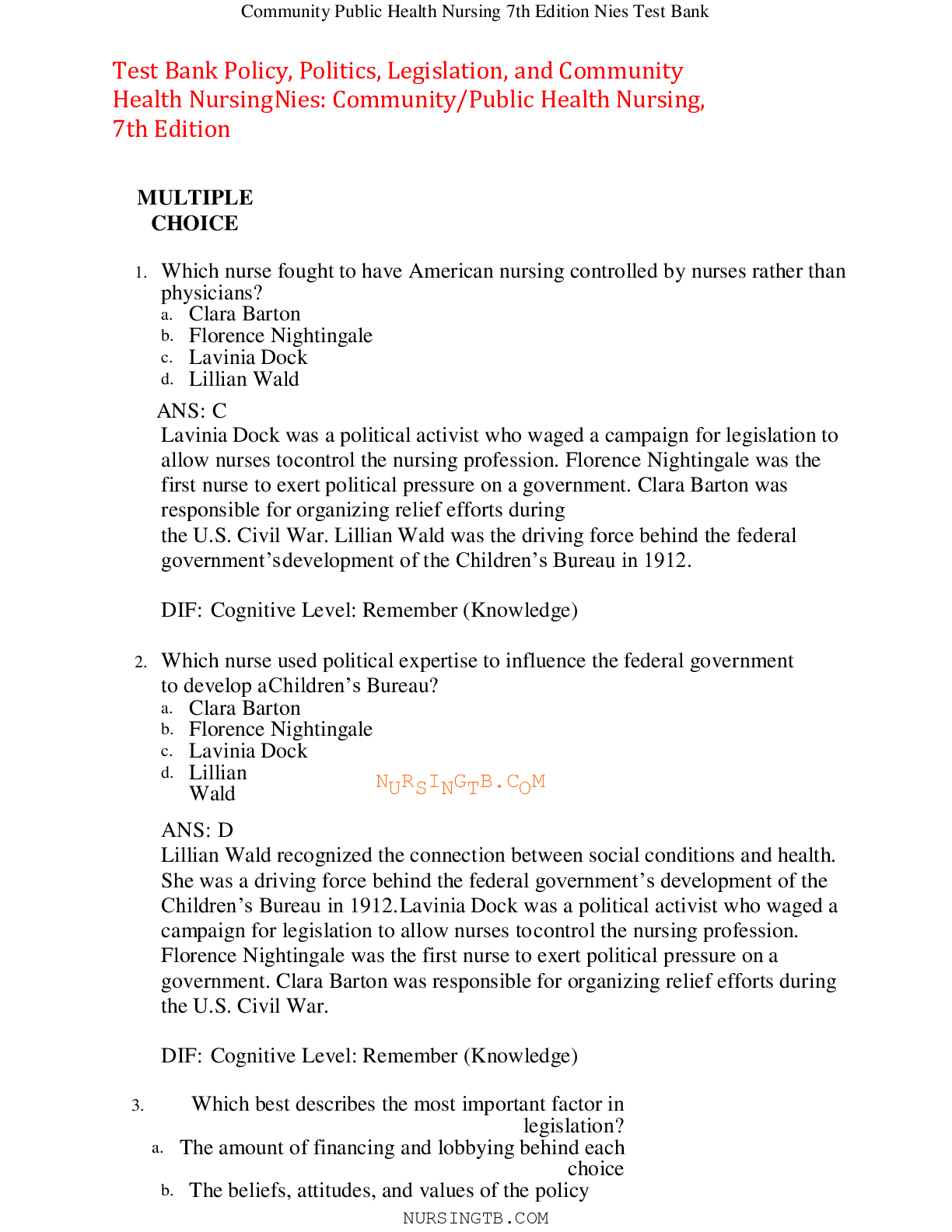


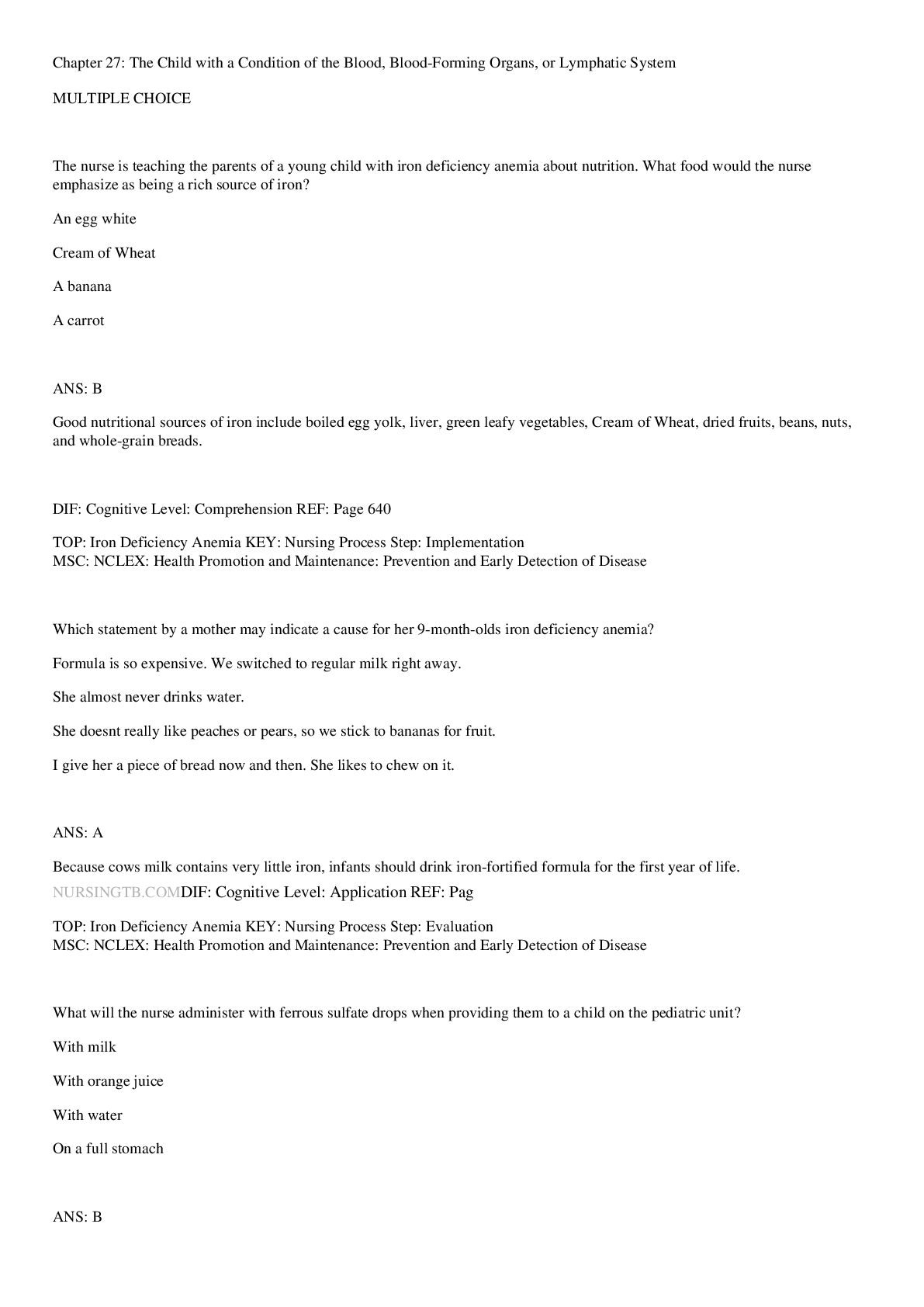



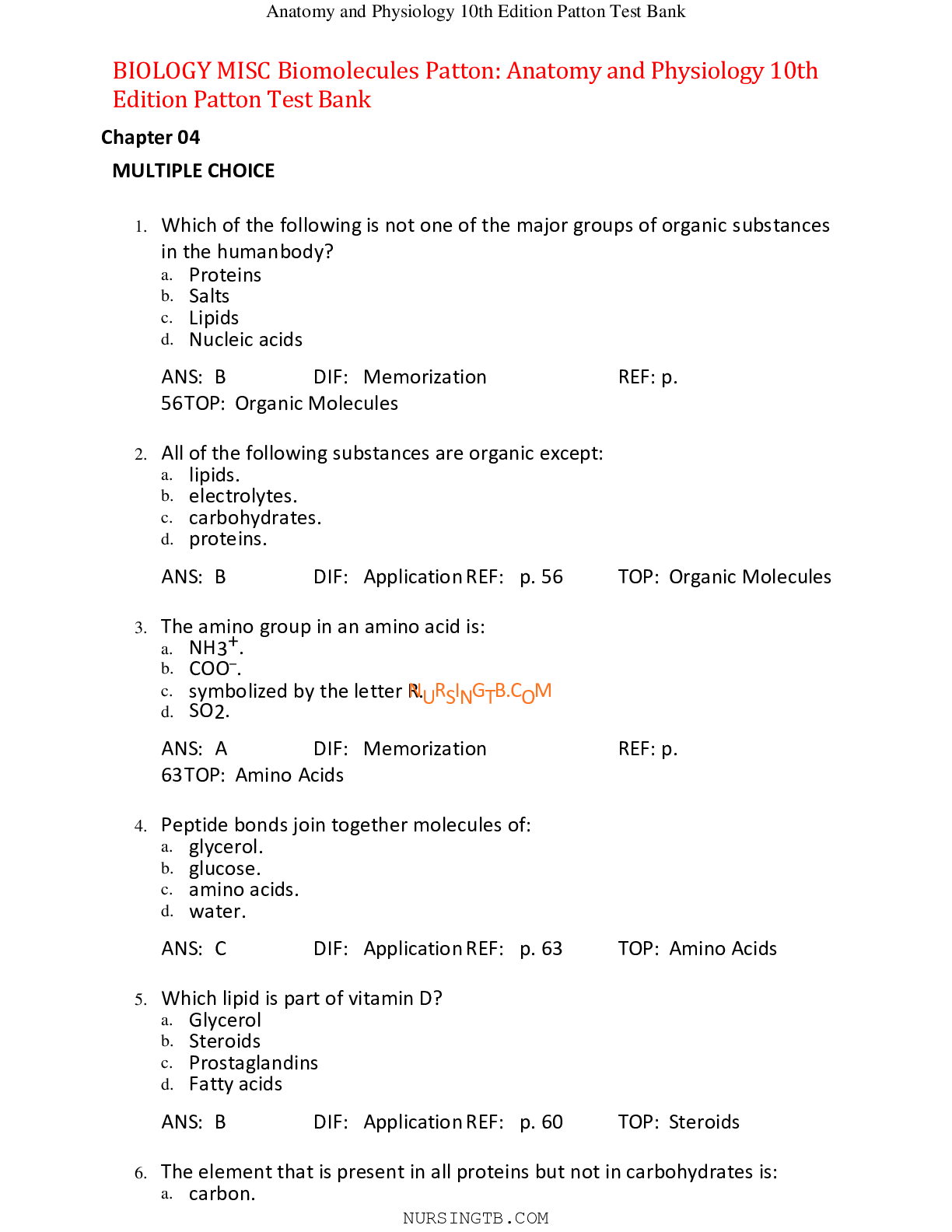







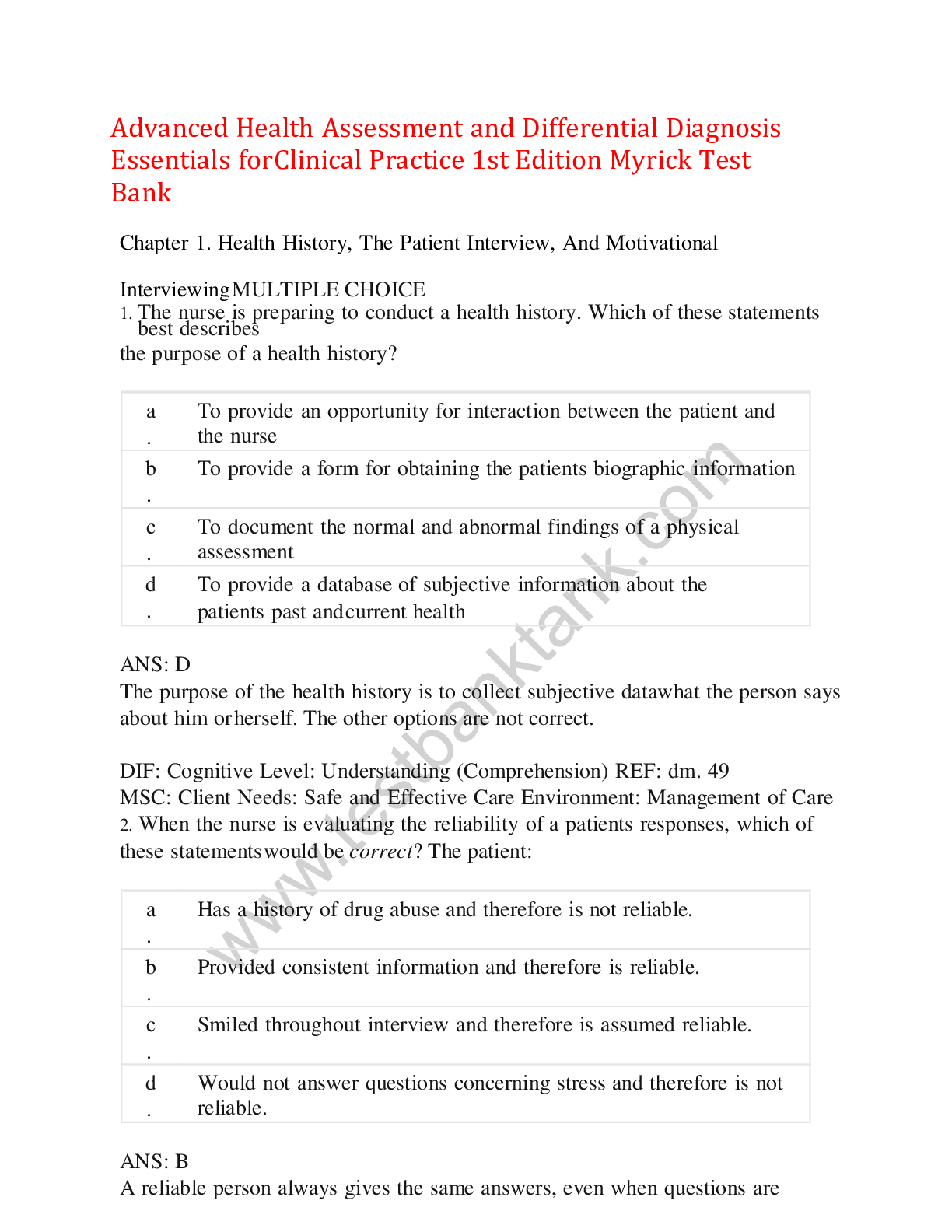
.png)
